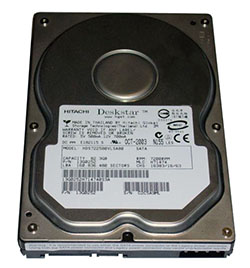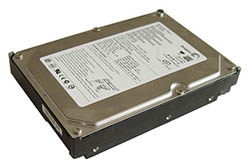Buyer's Guide - Entry Level to Mid-Range, March 2005
by Jarred Walton on March 15, 2005 1:30 PM EST- Posted in
- Guides
Hard Drives
With native SATA support provided by the chipset on all of the recommended motherboards, it only makes sense to go with a SATA hard drive. The difference in performance is generally negligible, but noise levels and storage capacities still vary. We're basically looking for a quiet drive with as much capacity as we can find without going over $75. 80GB models are the sweet spot these days, with 40GB models generally costing only a few dollars less and having higher noise levels.Hard Drive Recommendation: HItachi 80 GB 7200 RPM 8MB SATA
Price: $59 shipped
The Hitachi drives aren't the quietest hard drives around, particularly in terms of seek noise levels. Ball-bearing noise is not a problem, thankfully, as fluid dynamic bearings are used. With a price that's $15 lower than the competition, we're going to give the Hitachi the nod as the basic recommendation. If you want the longer warranty of a Seagate as well as a lower seek volume, the price will go up to $75 with shipping - still not bad at all, considering. Samsung 80GB drives cost about the same as the Seagate, and we would say that their seek noise levels are the quietest of the bunch. If you're using a quiet case that's located on top of your desk, you might find the noise of the drive heads seeking to be irritating on the Hitachi and even the Seagate. It is worth pointing out that various revisions of the Seagate and Hitachi drives may be more or less noisy, however. Some users still have bad memories of the "Deathstar" 75GXP IBM drives, but the latest models from Hitachi (who purchased IBM's hard drive division) have not shown any propensity for early failure, so we're okay with recommending them.
Hard Drive Alternative: Seagate 160 GB 7200 RPM 8MB SATA
Price: $94 shipped
Jumping up to the larger storage capacities, the price differences between the various brands tend to disappear. Given the longer 5-year warranty on the Seagate, it's the natural choice. We'll leave that up to you, but the same noise rankings as above still apply in our experience, with the Samsung having the least seek noise and the Hitachi having the most. The price for SATA and IDE versions of the 160GB drives is close to identical as well, should you feel the need to go with an IDE interface.












59 Comments
View All Comments
JarredWalton - Monday, June 13, 2005 - link
58 - ??? The Mid-Range to High-End went up a couple weeks ago. Next update in a couple more weeks, I guess. :Dhttp://www.anandtech.com/guides/showdoc.aspx?i=242...
SAV602 - Thursday, June 9, 2005 - link
This month?spartacvs - Saturday, May 14, 2005 - link
Yepeee!JarredWalton - Saturday, May 14, 2005 - link
It's coming soon! :pspartacvs - Thursday, May 12, 2005 - link
Hey guys, it's time for a new system guide :)TrogdorJW - Friday, March 25, 2005 - link
Sorry - ignore that last post, but I guess my comments name and pass don't work in the forums. Just wanted to check. :)TrogdorJW - Friday, March 25, 2005 - link
Testing....JarredWalton - Thursday, March 24, 2005 - link
jwf1776 sent me a reply email which updates the situation. I'll just post the text with links here:------------------
I don't know why I sent you the link the to enermax site, because the site does make it seem like its atx 2.03 ... but it's all lies...
The manual I got with the power supply was pretty clear about which models had 24pin rails. They have a 24P on the model number or something.
Anyways, the maxpoint site (American enermax distributor?) has the correct stats at
http://www.maxpoint.com/products/pow_supp/spec_pg/...
Also here is a review of the part
http://www.cluboverclocker.com/reviews/power/enerm...
Both sites make clear its atx 1.3
------------------
So, there you have it: the Enermax 375 is *not* a 24-pin EPS 12V compliant motherboard. It *does* have dual rails, which may be sufficient, but that's not the same as supporting the ATX 2.0x standard. It looks like Enermax needs to fix their spec pages....
JarredWalton - Wednesday, March 23, 2005 - link
jwf1776: I sent this in an email to him as well, but here's my question to you all: is this a case of false advertising by Enermax or not? Here is an image for the alternative PSU:http://www.enermax.com.tw/upload/clgcable0217.jpg
It doesn't have a 24-pin connector, per se, but it has a 20 pin with a second 4-pin connector that makes it into a 24-pin. Note that there is *also* a second 4-pin +12V adapter for the standard P4 power connector. Unless someone can confirm that the PSU doesn't include the two 4-pin adapters, I believe it still qualifies as a 24-pin PSU. ATX 12V 2.01 vs. ATX 12V 2.03 - is there really a major difference other than the 24-pin adapter bein in one piece?
Jep4444 - Wednesday, March 23, 2005 - link
48 - the adapter doesn't do very much, it'll work without an adapter